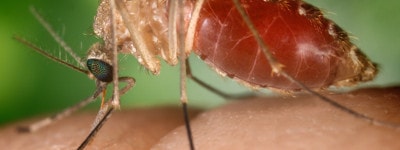Mosquito-Borne Diseases

Protecting workers from mosquito bites can prevent diseases.
Mosquito-borne diseases are those spread by the bite of an infected mosquito. Diseases that are spread to people by mosquitoes include Zika virus, West Nile virus, Chikungunya virus, dengue, and malaria.
Employers should protect workers and workers should protect themselves from diseases spread by mosquitoes. Although people may not become sick after a bite from an infected mosquito, some people have a mild, short-term illness or (rarely) severe or long-term illness. Severe cases of mosquito-borne diseases can cause death.
Workers at Risk
Workers are at risk when they are working where mosquitoes are biting. Different species of mosquitoes are found in varying geographic locations, are most active at different times, and spread different diseases. The risk to workers varies with where they are working in the United States or elsewhere, type of habitat at the work site, season, and time of day.
Workers at risk include:
- Outdoor workers
- Business travelers who may travel to areas with mosquito-borne diseases
- Laboratory workers who may work with potentially infected samples, cultures, or arthropods
- Healthcare workers who may handle patients who are, or might be infected with certain mosquito-borne diseases. Transmission may occur through a break in their skin or via a sharp penetration injury.
Employer Recommendations
- Some mosquitoes lay eggs in or near standing water. Decrease the numbers of mosquitoes at worksites by:
- removing, turning over, covering, or storing equipment
- removing debris from ditches
- filling in ruts and other areas that collect standing water
- removing tires, buckets, bottles, and barrels that collect water
- placing drain holes in containers that collect water and cannot be discarded
- Keep mosquitoes outside by ensuring that doors and windows have screens and are kept closed when possible.
- Provide training about:
- the risk of mosquito bites and how to prevent them
- symptoms of mosquito-borne diseases
- the safe use of insect repellents
- Provide workers with, and encourage them to wear, clothing that covers theirs hands, arms, legs, and other exposed skin. Consider providing hats with mosquito netting to protect the face and neck.
- Provide Environmental Protection Agency (EPA)-registered insect repellentexternal icon with one of the active these ingredients: DEET, picaridin (known as KBR 3023 and icaridin outside the US), IR3535, oil of lemon eucalyptus (OLE), para-menthane-diol (PMD), or 2-undecanone.
- Provide permethrin for application to clothing and gear
Worker Recommendations
- Use EPA-registered insect repellentsexternal icon with one of the active these ingredients: DEET, picaridin (known as KBR 3023 and icaridin outside the US), IR3535, oil of lemon eucalyptus (OLE), para-menthane-diol (PMD), or 2-undecanone.
- Find the right insect repellent for you by using EPA’s search toolexternal icon.
- When used as directed, EPA-registered insect repellents are proven safe and effective, even for pregnant and breastfeeding women.
- If also using sunscreen, apply sunscreen first and insect repellent second.
- Permethrin can be applied to clothing and gear.
- Wear clothing that covers hands, arms, legs, and other exposed skin. Wear hats with mosquito netting to protect the face and neck.
- Remove standing water (for example, tires, buckets, barrels) to reduce places where mosquitoes lay eggs
- Workers who develop symptoms of a mosquito-borne disease should report this promptly to their supervisor and get medical attention.
-

CDC Avoid Mosquito Bites
Mosquito bites can be more than just annoying and itchy. They can make you sick. -

CDC Insect Repellent Use and Safety
Answers to common questions about the safe use of repellents. -
NIOSH Fast Facts: Protecting Yourself from Ticks and Mosquitoespdf icon
Print or order this free card for easy access to important safety information. -
California Department of Pesticide Regulation: Fight the Bite! Protecting outdoor workerspdf iconexternal icon
Mosquitoes can carry diseases, including West Nile virus. The best way to avoid infection is to avoid being bitten. There are many steps employers and workers can take to make outdoor work safer. -

US EPA Mosquito Controlexternal icon
About mosquitoes, prevention, repellents, and pesticides.


